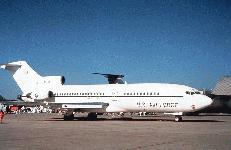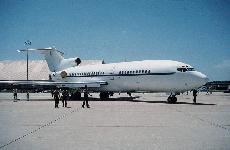





The C-22B, a Boeing 727-100, is the primary medium-range aircraft used by the Air National Guard and National Guard Bureau to airlift personnel. The C-22B's unique arrangement of leading-edge devices and trailing-edge flaps permit lower approach speeds, thus allowing operation from runways never intended for a 600-mph (Mach 0.82) aircraft.
The aircraft has heated and pressurized baggage compartments - one on the right side forward and the second just aft of the wheel well. The two compartments provide 425 cubic feet (12.75 cubic meters) of cargo space. The fuselage also incorporates a forward entry door and hydraulically opened integral aft stairs in the tail cone.
The flight controls consist of a hydraulically powered dual-elevator control system with control tab to assist during manual operation. Hydraulically powered rudders use two main systems with a standby system for the lower rudder. The ailerons also are powered by dual-hydraulic systems. They have balance tabs on the outboard and control tabs on the inboard, which assures adequate maneuverability in the event of a total hydraulic failure. The flight spoiler systems assist ailerons and also function as speed brakes. The aircraft's tricycle landing gear consists of a dual-wheel nose gear, left and right dual-wheel main gear, and a retractable tail skid which prevents damaging the aircraft in case of overrotation. Nose wheel steering is hydraulically powered and controlled by a steering wheel to approximately 78 degrees in either direction. Fuel is contained in three main tanks inside the wing center section. Rapid pressure fueling and defueling is accomplished at the fueling station on the right wing. The total fuel capacity is approximately 50,000 pounds (22,500 kilograms) of JP-4. Fuel may be dumped down to 35,000 pounds (15,750 kilograms) from all tanks.
The C-22B requires four crew members and three or four in-flight passenger specialists for passenger service and safety. The avionics package includes one UHF and two VHF radio altimeters, variable instrument switching and two Collins FD-108 flight directors. A third vertical gyro and an additional VHF transceiver are available in case of failure of the primary systems.
The C-22B was introduced by the airline industry in 1963. It proved to be a major innovative design with its three Pratt & Whitney JT8D turbofan engines, one on each side of the rear fuselage and the third in the tail cone. Currently, there are three C-22B's in use, all assigned to the 201st Airlift Squadron, District of Columbia Air National Guard.
The C-22Bs are modified Boeing 727-100 series aircraft, out of production since 1969. Spare parts are increasingly costly and difficult to obtain as commercial operators phase out this series of Boeing 727 and supply sources dwindle. The current fleet suffers from numerous operational restrictions. The aircraft are aging and have high operating, maintenance, and support costs. Communication and navigation systems are old and fail to meet the new requirements for air traffic management and separation mandated by Reduced Vertical Separation Minimums (RVSM) and Global Air Traffic Management (GATM) requirements. The C-22B fleet fails to meet either FAA or International Civil Aviation Organization (ICAO) Stage 3 noise and air pollution requirements. The Pratt & Whitney (P&W) JT-8 engines, which power the C-22B, are out of production and no new spare parts are being manufactured. The engines are expensive to operate, and emit more pollutants than newer, more fuel-efficient engines. The aircraft are heavily dependent upon ground support equipment, and are the only C-22Bs flying in the USAF.
The C-22 Replacement Program calls for a most probable quantity of four (one initial plus three options) FAA certified commercial intercontinental passenger aircraft reconfigurable to accommodate a minimum of 40 passengers and 7 crew (low volume, office environment with DV area) or a minimum 70 passengers and 5 crew (high volume passenger transport). The ability to reconfigure the interior for medical evacuation by installing 1 to 7 Spectrum 500 beds is also required. The aircraft shall be capable of dispatch on short notice to any suitable airfield in the world from operating locations at Andrews AFB, Maryland and shall be capable of non-stop flight from Andrews AFB, Maryland to Moscow, Russia and from Frankfurt, Germany to Andrews AFB, Maryland with 7 crew and 40 passengers. Worldwide clear and secure voice, facsimile, and data communications are required to support the passengers.Specifications | |
| Primary Function | Passenger transportation
|
| Builder | Boeing Co. |
| Power Plant | Three JT8D-7 turbofan engines |
| Thrust | 14,000 pounds each engine |
| Length | 133 feet, 2 inches (40.3 meters) |
| Height | 34 feet, (10.3 meters) |
| Wingspan | 108 feet (32.7 meters) |
| Maximum Take-off Weight | 170,000 pounds (76,500 kilograms) |
| Maximum Payload | 20,000 pounds (9,000 kilograms) |
| Maximum Speed | 619 mph (Mach 0.82) |
| Range | 2,000 miles (1,739 nautical miles) |
| Endurance | 5.5 hours |
| Crew | Pilot, co-pilot, flight engineer, flight mechanic, and three or four in-flight passenger specialists |
| Unit Cost | No longer available. |
| Date Deployed | 1963. |
| Inventory | Active force, 0; ANG, 3; Reserve, 0. |


